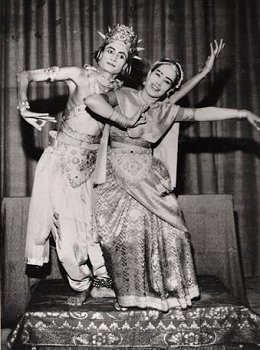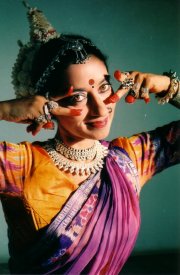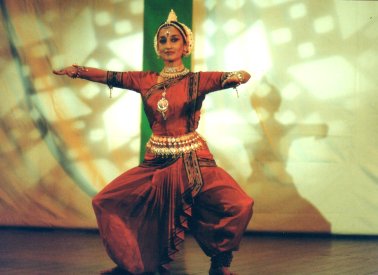
|
 |

|
 |
Dance in Pakistan - Sheema Kermani, Pakistan e-mail: tehrik@gmail.com October 23, 2010 Background Dance has always been an integral part of the culture of the sub-continent. The Aryans never wrote any history; instead all subjects were clothed in the garb of mythology, which was passed on from generation to generation by word of mouth as "Kathas" or stories. To make these stories more interesting, the "Kathakars" or "Kathaks" who were the original story tellers, used all at their disposal- i.e. song, rhythm, movement, expression etc, and they were the narrators of these stories. This is how classical dance came into being in the subcontinent. Traditionally in the sub-continent, dance, music and drama cannot be separated and together constitute the theatrical arts. They are elements of a unified reality, they are deeply intertwined and their goal is to lead the spectators towards wisdom, knowledge and liberation: "To uplift the soul to realms above..." (Bharata's Natyashastra) Pakistan's cultural heritage dates back to 2,500 B.C. The beautiful statuette of "The Dancing Girl" excavated from the ruins of Mohenjodaro is one of the earliest sculptural evidence of ancient dance forms in the world. But unfortunately, soon after Pakistan came into being, it was declared that there was no dance in this area and the beautiful figurine was given away as a present to India. The original now stands in the Delhi Museum while the National Museum in Karachi only has a copy. A fundamental requirement for the development of the Performing Arts in general and for Dance in particular is complete freedom of expression and thought. Arts can only exist in a society that is tolerant of divergent opinions and open to questioning on every conceivable aspect of life. Unfortunately this is made impossible in Pakistan, not only by the state, which imposes censorship for its own reasons, but also because of the intolerant attitude of the fundamentalists. Any divergence from traditionally held beliefs or expression of an idea, which goes against the grain of one or the other sect, brings with it the threat of physical violence. The roots of the problem maybe lie in the nature of the State and the Society. The Pakistani State since its inception has had problems with the question of identity and the heritage that belongs to the sub-continent. For most part of its history, Pakistan has had martial law governments and even the civilian government's cultural policies have had 'concealed fascism' in their behaviour. Dancers in Pakistan In its search for a cultural identity as apart from the cultural identity of India, Pakistani establishment has looked upon the Art of Dance with suspicion. It has continuously been claimed by the official authorities that dance is not part of Pakistani culture. However the early two decades of Pakistan were relatively moderate and liberal for the arts. Soon after 1947, dancer Madame Azurie moved from Bombay and set up an academy of dance in Rawalpindi but this was short lived due to lack of financial funds. Madam Azurie then moved to Karachi where she met Rafi Anwer, another dancer who had migrated from Bombay. Madame Azurie and Rafi Anwer paired up and choreographed and presented many performances as duets for many years. Both Rafi Anwer and Madame Azurie taught students and continued to teach as long as they lived. Around the same time in Karachi, there was Bulbul Academy set up by dancers Bulbul Chowdry and Afroza Bulbul. Then in 1954, Mr. and Mrs. Ghanshyam were invited by Prime Minister G.H. Suhrawardy to establish an academy of dance and music called the 'Rhythmic Art Centre' which they set up in Karachi. Mr. Suharwardy knew Ghanshyam from Calcutta and offered him and his institute patronage and funds.  In pre-partition Lahore, Zohra and Kameshwar Seghal had set up Zoresh Dance Institute, but because of the political unrest, they closed down and moved to India just before partition. Ustad Ghulam Hussain Kathak of Patiala Gharana came from Dhaka in 1949 and settled in Karachi where he lived for 20 years and then in 1969, he shifted to Lahore where he spent most of his time teaching Kathak. Ghulam Hussain earned a name for himself as a teacher rather than a performer. Dr. Faqir Hussain Saga was a veterinary doctor with a passion for dance. In 1958, he became a student of Madame Azurie and then got a scholarship to learn dance in India. Dancers like Amy Minwalla and Parween Qasim, the daughter of dancer Mohammad Qasim, were performing both on stage and in films. In the 1950s and 60s, Karachi had many bars, night clubs and cabarets, dancers would come from abroad to perform and it seemed that Pakistan needed to promote itself through its art and culture. The new Pakistani International Airlines had just been established and the government felt that the young Pakistani state needed a positive promotion and this could be done through a Performing Arts Ensemble. At that time Karachi was the capital of Pakistan, a cosmopolitan city with a large foreign population as all the embassies were situated here. So in 1966, the PIA Arts Academy came into being under the patronage of Pakistan International Airlines, with Mehr Nigar Masroor as its director and choreographer. With the creation of Bangladesh in 1971 the atmosphere in the country changed. Z.A. Bhutto introduced the ban on alcohol and banned cabaret dancing. He tried to form the pan-Islamic brotherhood and link Pakistan politically to the Middle-East. Most of the Bengali artists moved away to Bangladesh; The Bulbul Academy and the Nazrul Academy both closed down. General Zia-ul-Haq imposed Martial Law in 1977. In his policy towards the so-called Islamisation of society, he tried to link Pakistan both politically and culturally to the Middle East, with devastating effects. Everything had to be justified in terms of ideology. And since the ideology was vague, it could be used to condemn or support whatever served his political goals. He disbanded the Arts Councils, the National Performing Arts Group, banned dancing by women on stage and implicitly termed dance "un-Islamic". He also introduced anti-women laws. The arts and the women of Pakistan have been the two major victims of Zia's policies. The state introduced legal and social forms of control over women as part of its campaign of suppression and made women's sexuality and morality the business of the state. State forces were preoccupied with women's dress, their movements, their sexuality and their very presence in public spaces. In the name of religion, laws like the "Hudood Ordinances", "Qisas", "Diyat" and "Blasphemy Laws" were introduced and are prime examples of laws that devalue women, arts and humanity. The very first programme that was banned on PTV by General Zia ul Haq was 'Payal,' a dance programme  
Sheema
Naheed Siddiqui had learnt Kathak
from Ustad Ghulam Hussain and then joined the PIA Arts Academy. With the
new law forbidding women to dance in public and the PIA Arts Academy being
shut down and the TV dance programme 'Payal' being banned, Naheed
decided to leave Pakistan and settled in the UK. By this time, Ghanshyam's
'Rhythmic Art Centre' had stopped getting any government support or funding
and they started getting threats, to the extent that they were forced to
close down, leave the country and settle in the USA.The decade of the 80s saw almost all the dance performers leaving Pakistan. I was the only dancer who throughout this period continued dancing in spite of the ban. I had learned originally from the Ghanshyams and then gone to India and studied Bharatanatyam from Leela Samson, Odissi from Guru Mayadhaur Raut and Aloka Pannikar and Kathak from Ram Mohan, all renowned gurus in Delhi. I returned to Pakistan in 1983 and then stayed on in Pakistan, teaching, choreographing and performing. Other dancers who later emerged on the scene are Nighat Chaudry, Fasih ur Rahman and Tehreema Mitha. Nighat and Fasih were both Kathak students of Ghulam Hussain and Tehreema had learnt Bharata Natyam from her mother Indu Mitha. Indu Mitha had grown up in Lahore and learnt from Zohra Sehgal at the Zoresh Institute. She then taught dance to school children and also to her daughter. Both Fasih and Tehreema have moved away from Pakistan while Indu Mitha continues to teach in Islamabad. Naheed has now settled in the U.S. so once again there are just a couple of us left in Pakistan who continue to pursue dance. The major forms of classical dance that are practised in Pakistan are: 1. BHARATANATYAM, a highly stylised and sophisticated technique has a geometric quality both in its form and in its spatial choreography. 2. KATHAK is a whirling dance. 'Kathak' was a storyteller who incorporated poetry and dances - syllables 'bols' into her/his stories. Though Kathak was a pre-Muslim dance, it was patronised by the Mughals and acquired its polish at the Mughal courts, when it became a court dance. In this style, the emphasis is on Layakari, footwork and lightning pirouettes. 3. ODISSI traces its origins to the posture of the dancing figurine found from the ruins of Mohenjodaro. It is a rhythmical, swaying, lyrical and powerful dance, recreated on sculptural evidence. 4. MANIPURI is the dance from the valley of Manipur, north east of the subcontinent. The dances of Manipur are known for their lyrical grace, lightness of tread and delicacy of hand gestures. Folk Dances of Pakistan: Like all other countries of the world, Pakistan also has a rich variety of folk dances. Folk dancing is an expression of joy- a celebration of life, its beauty and colour! They have a sense of freedom, with regional affinities and differences and a charm of their own. Through these arts, custom and tradition have been established and with their continuance, Pakistani culture is richer. PUNJAB Luddi: A popular feature of the wedding celebrations in Pakistan is the Luddi danced by women friends and family members of the bride. This dance originated in the Punjab but has now become an integral part of weddings throughout Pakistan. Bhangra: Typical of the colour and vigour of the Punjab, the Bhangra is rooted in the soil. Spurred on by the beat of the drum, and the rhythm of the 'Chimta' (a pair of tongs used to rake coals), girls and boys dance with abandon, secure in the knowledge that the harvest is good. N.W.F.P Khattak: The Khattak dance from the mountainous terrain of the legendary Khyber Pass is performed by an all male group of hardy tribesmen. It celebrates the valour of the Pakhtoons who successfully resisted attempts to subjugate them and colonise their land. One of the most powerful of the regional dances, Khattak requires great stamina and vigour. Hunza Dance: In the north of Pakistan lies the mountain-locked beautiful valley of Hunza, a veritable paradise on earth. The lovely Hunza girls enjoy the outdoors - the lush green of the valley, the chill in the air - as they come together to perform this simple dance to the accompaniment of a flute and a drum. Kalash Dance: In the extreme North Western region of Pakistan, where the mountains meet the sky is the Kalash Valley inhabited by people believed to have descended from the warriors of Alexander the Great. The area remained inaccessible to the outside world for centuries and has retained its pagan purity even today. The Kalash dance depicts the people's closeness to nature, which is an inherent quality of their life. The attractive headgear of the girls, decorated with courie shells, supports a theory that the valley was once covered by the sea. SINDH Jhoomer: The Sindhi Jhoomer dance is performed by village girls to celebrate a good harvest. Dressed in their swirling full-skirted costumes and silver jewellery, they are joined by boys who sing a popular song 'Ho Jamalo'. Ho Jamalo: Ho-Jamalo is one of the most popular folk songs of Pakistan. It celebrates the gallantry of the 18th century warrior, Jamal Khan Rind, who defended his homeland from foreign invaders. Tales of his courage spread from village to village. Dandia: From the soil of the Tharparkar district in Sindh is the Dandia (stick) dance. Boys and girls with lacquered sticks in hand swing to the beat of the drum and produce an interesting mix of rhythms as they clap their sticks together. BALUCHISTAN Do-Chapi: This is danced with hand clapping based on varying rhythmic patterns, gradually mounting to a crescendo. The Do-Chapi dance is typical of the rugged Baluchis, and generally performed by men in the interior of Baluchistan. Fishermen's Dance: A hardy and cheerful people, the fishermen from the coast of Makran in Baluchistan set out in their boats before sunrise and return home at sunset with a rich haul. This dance captures the rhythm of the fishermen's life. Leva: The traditional Leva danced by men is a common feature at weddings and other happy occasions in the tribal society of the Baluchis. This dance has a hypnotic beat and an evocative rhythm. An interesting genre of dance practiced in Pakistan is what may be called devotional dancing known as Dhamal performed both by men and women at the mazaars and shrines of Sufi saints. Even though this was also banned by General Zia-ul-Haq, it still continues. Perhaps it would be of importance to mention here that some of the Sufi saint poets of this region were dancers themselves. Of course we have Ameer Khusrau, who created the musical genre Qaul or Qawalli and sang and danced at the grave of his Pir Nizamuddin Auliya, but we also have Bulleh Shah, Madhu Lal Hussain and Shah Abdul Latif Bhittai who were themselves dancers and at whose shrines the public still dance and sing.
However, No Objection Certificates (NOC), must be obtained prior to putting up performances on public stages. This involves a long, tortuous, and humiliating process of standing in queues in government offices for police clearances, excise stamps, papers and censorship of the most ludicrous variety. Anti-blasphemy laws hinder the freedom of expression of all artists including dancers. Government support and recognition remain negligible. Only a few dancers continue to teach and perform and some of my students are now teaching at various schools in Karachi. These are of course private schools where young students are taught dance but they are referred to not as dance classes but movement classes. Dance is 'officially' still banned - we do perform in auditoriums but we are cautious and try not to advertise too much, and yes, we perform at corporate shows and at cultural centres like Alliance Francaise and Goethe Institut and sometimes in halls and hotels where we have to take especial permission. Off and on there have been efforts at Dance Festivals but they are infrequent and few - I also regularly hold shows for myself and my students and organise dance and theatre festivals in Karachi. Since 2000, Rafi Peer Dance and Theatre Festival used to take place in Lahore, where a couple of times some international dancers and groups had come and performed. But for the last three years it has not taken place due to security reasons and lack of financial support. So it would not be incorrect to say that the future of classical dance in Pakistan is bleak. |